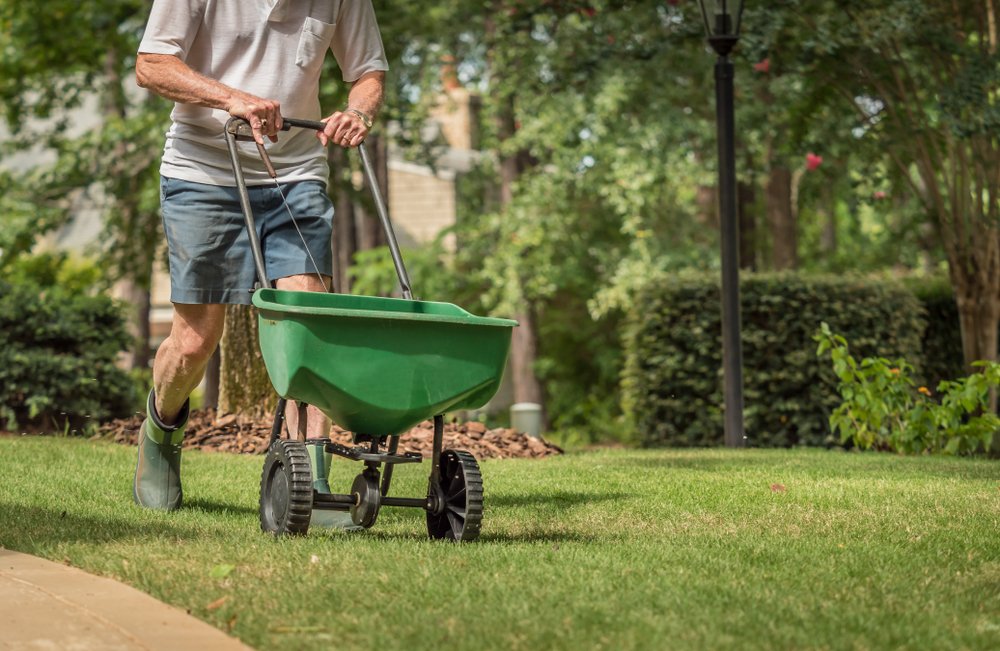The lawn is the first thing friends, family, and other guests notice when they first venture onto a property. Well-manicured and healthy grass acts as the perfect field for backyard football games and as the dance floor for family cookouts. Doubtlessly, it leaves an impression.
But over time, the traffic of people and pets combined with the often unforgiving weather takes its toll on the lawn. The grass becomes thin or trampled or wilted over time, and the only remedy to restoring the yard is to properly overseed it so that new grass will grow in its place.
Below you will find six easy steps for overseeding an existing lawn to keep the lawn a point of pride.
If you are looking to raise a pristine lawn, you’ll want to check out our article on how to care for Zoysia grass here on the Green Pinky.

1. Ideal Timing
The best time to overseed depends on where you are located and the type of grass you will be planting.
In the North, it is generally better to do it in the fall. During this time, the soil remains warm while the air becomes cooler. There are also fewer weeds to compete with your new grass. If you are unable to do it in the fall, then the next best time is in the Spring.
In the South, the best time to overseed is in the late spring through the mid-summer. Warm-season grasses (more on this later) need warmer temperatures to germinate.
2. Mow the Lawn
Before you begin to overseed, mowing the lawn is essential.
By scalping (setting the lawnmower blade to its lowest height) the lawn before overseeding, you are ensuring two different things:
- The new seed must reach the soil, so cutting the grass to a maximum of 2″ will allow the seed to reach the soil and prevent the seed from getting hung up on blades of existing grass.
- Once seeds reach the soil, they will need water, light, and nutrients to germinate. Mowing the lawn to the specified height assures that the new grass will not compete with weeds and existing grass for these key ingredients.

If possible, use a grass catcher on the lawnmower to collect clippings as it is being cut. After mowing the lawn, it is necessary to rake the lawn to remove excess clippings and other debris and loosen the soil so that the overseed will reach the lawn’s surface.
If the lawn is used heavily by people and pets or was established as part of a newly constructed home (which can cause stripping of the topsoil) it may be necessary to aerate the lawn before putting down new grass seed. Aeration holes in the lawn alleviate the issues related to compacted soil and will promote proper circulation of water, air, and nutrients in the soil to guard against the roots of the grass being starved of these essentials.
If practical, you can test a soil sample to establish that it is not lacking in any key nutrients and that the pH balance of the lawn is within an acceptable range.
3. Select a Quality Seed
Growing season differs in the North and the South, and so do the types of grass that thrive and grow in these different geographic regions.
In the North, the spring and the fall months provide the ideal conditions for overseeding and growing new grass. You will want to grow cool-season species. Examples of these cool-season grass include:
- Kentucky bluegrass (Poa pratensis)
- Perennial ryegrass (Lolium perenne)
- Fine fescue (Festuca sp.)
- Tall fescue (Festuca arundinacea)
- Annual ryegrass (Lolium multiflorum)
- Creeping bentgrass (Agrostis stolonifera)
- Rough bluegrass (Poa trivialis).
These species also grow well in the transition zone, which runs across the middle section of the United States.

In the South, the late spring months through the middle of summer affords one the optimal conditions for sowing seeds. The warm-season seeds include:
- Bahiagrass (Paspalum notatum)
- Bermuda grass (Cynodon dactylon)
- St. Augustine (Stenotaphrum secundatum)
- Carpet grass (Axonopus)
- Zoysia grass (Zoysia japonica).
These species also grow well in the transition zone but will not thrive too far north as these require more moisture and warmer temperatures to thrive.
Be sure to select a seed that corresponds to your geographic region and matches your current grass type for aesthetic continuity.
4. Spread the Seed
To haphazardly spread the seed onto the newly prepared lawn is ill-advised.
To properly seed smaller areas of the lawn it is best to spread by hand to personally certify that a proper amount of seed will fall into the desired location. For larger areas, a hand spreader or a push style lawn spreader will generally disperse the proper seed numbers. For commercial and other large lawns, overseeding can be done using a mechanical spreader attachment on a riding lawnmower or utility vehicle.

Ideally, the optimal seed coverage is between 14 and 18 seeds per square inch. Anything less than this range will not provide enough grass to cover the chosen area. A ratio higher than this causes competition for water and nutrients from the soil and does not promote the healthy establishment of roots.
5. Fertilize the Area
Two or three days before using fertilizer on the new grass seed, the lawn must be liberally watered to ensure that the seed is ready to be fed with the nutrients in the fertilizer.
Select a starter fertilizer as these are rich in phosphorus and nitrogen, which promote photosynthesis and normal development. Before fertilizing, adjustments to the spreader, either broadcast or drop style, need to be made to make sure the coverage ratio matches the fertilizer type as these are all different for different products. These ratios for coverage can be found on the fertilizer bag and, frequently, the spreader itself.

To ensure complete coverage, begin spreading the fertilizer on the lawn’s perimeter to guarantee that the edges of the overseeded area receive the nutrients as well. Once the outside edges are covered, fill in the middle area of the lawn by walking back and forth over the area as you would with a push lawnmower. Slightly overlap with each successive pass to ensure the area is entirely covered with the fertilizer.
When finished, return the unused product to the bag and store it in a cool, dry place for future use.
6. Ongoing Maintenance
First and foremost, traffic of any kind on the newly seeded lawn is discouraged for the first month as this time is vital for seed germination. Limiting the amount of contact with the lawn gives the prime conditions necessary for new seeds to germinate and sprout new growth.
During the first and second weeks following aeration and overseeding, grass should be watered daily for 15 to 20 minutes to promote growth. Be careful not to overwater as the seed can be washed away.
The best time to water the lawn is generally in the morning when it is cooler. This gives the seed a chance to thrive in the moisture from the water and dry out from the light of the afternoon sun. Watering at night is not recommended as this often creates an environment that promotes fungus and disease.
For the third and fourth weeks watering should be scaled back to every other day. By this point, the seed has germinated and is beginning to take hold and grow. Keep the new seeds moist but be careful not to overwater as the excess water will not evaporate and promote disease and fungus once the sun goes down.
Once the grass reaches 4″ it is ready to be mowed. Make sure to set the mower blade at the maximum height to avoid scalping the new grass as it is still relatively fragile and working on setting up a new root system. Discontinue watering 1 day before mowing and make sure the lawn has had time to dry out.

Proper lawn care beyond the first month returns to a regular maintenance schedule, but be gentle with the lawn as the root system is newly formed and will need to continue to establish itself. To aid in this establishment, water the lawn twice a week, making sure that the grass receives 1″ of water.

